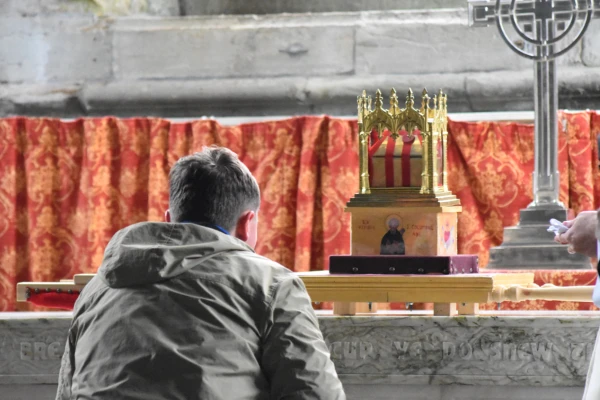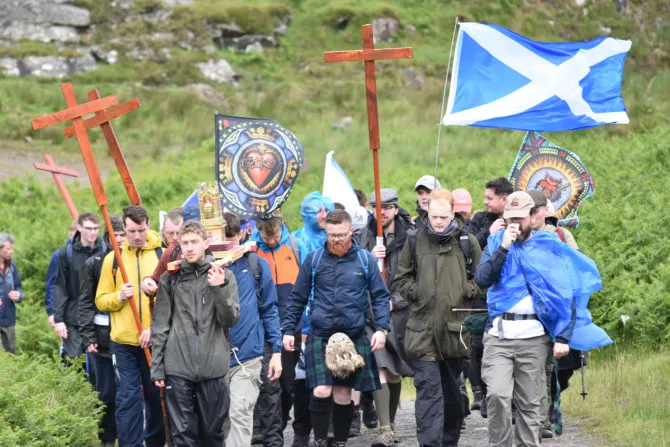Pilgrims traveled on foot and by ferry from the Scottish west coast, across the Isle of Mull, and to Iona Abbey during the Brecbannoch Pilgrimage June 11–13. The group celebrated Mass at the ruins of Iona Nunnery, a Benedictine convent founded in the 13th century. They then held a procession to Iona Abbey, rebuilt in the 20th century at the site of St. Columba’s community. | Sancta Familia Media
Catholic pilgrims have again returned to Iona, the coastal island where St. Columba launched the evangelization of Scotland more than 1,400 years ago.
Sixty people walked for dozens of miles from June 11 to 13 to pray for Scotland, for spiritual renewal amid the pandemic, and to return a relic of the missionary Irish saint to the site of his deeply influential monastic community.
“The route taken involved blistering winds and rain, and some scorching sun,” pilgrimage director Jamie McGowan told CNA June 15. “We also had to wade through a few bogs. But the beauty of that was knowing that such conditions were the conditions that St. Columba himself would have faced when preaching the Gospel to the surrounding islands.”
The Brecbannoch Pilgrimage took place as the pilgrims travelled on foot and by ferry from the Scottish west coast, across the Isle of Mull, and to Iona Abbey. The walking portion of the journey was 50 miles long.
The pilgrimage takes its name from the Brecbannoch of St. Columba, a reliquary that had major significance in Scottish history. The object containing the relics of the saint was brought to important meetings of the Church and of the government to seek Columba’s intercession. The Scottish army would carry the Brecbannoch into battle.
“Now we carry it to pray for a renewal of the Catholic faith in Scotland,” McGowan said of the pilgrims’ reliquary replica.
The pilgrims’ replica is modelled on a national treasure of Scotland: the Monymusk Reliquary, a house-shaped container for saints’ relics. The National Museums Scotland said that many identify the Monymusk Reliquary as the Brecbannoch, though this has not been confirmed.
The pilgrimage reliquary contains the relics of St. Columba, St. Andrew, and St. Margaret of Scotland, the country’s patron saints.
Pilgrims waved the flag of Scotland and other religious banners and took turns carrying the reliquary on the journey to Iona. Their relic of St. Andrew is a piece of the cross on which St. Andrew the Apostle was crucified, and this cross is represented in the Scotland flag’s white saltire (diagonal cross).
Their destination was on the island of Iona, in the Inner Hebrides of Scotland’s northwest coast. The island is only 3 miles by 1.5 miles wide, but it was there in the sixth century that Irish missionary St. Columba and his companions built simple monastic quarters and a church for themselves. They ministered to Irish settlers and evangelized the pagan Picts of the region.
“Iona has played a crucial part in Scottish history, where kings were crowned, married, and buried, and where pilgrims brought their petitions for centuries,” McGowan said. “Today, it maintains this status as a key historical monument in Scottish history. But for us as a Christian people, it is, of course, more than a political monument: it is a shrine, not only of the many holy saints buried there but also of the faith of many generations of Scots who journeyed great lengths to pray there.”
The latest pilgrimage to Iona began June 11 at St. Columba’s Cathedral in the west coast town of Oban, where Bishop Brian McGee of Argyll and the Isles celebrated a 6 a.m. Mass for the pilgrimage.
Pilgrims held a procession to the port and then took a ferry to the Island of Mull, the large island to the east of Iona. They camped the night in a field, then walked to Kilvickeon Chapel, a ruined medieval church. After further travelling and camping the night, they took the ferry to Iona.
The group celebrated Mass at the ruins of Iona Nunnery, a Benedictine convent founded in the 13th century. They then held a procession to Iona Abbey, rebuilt in the 20th century at the site of St. Columba’s community.
The pilgrimage concluded with Solemn Benediction with the relics in the abbey’s chapel.
The St. Columba relic came from the relic collection at Carfin Grotto in Motherwell, Scotland.
“St. Columba’s relics were removed from Iona during the Reformation, so their return on Monday is the first time that St. Columba’s bones have returned to Iona since the Reformation,” McGowan said.
A storied life
St. Columba, also known as St. Colmcille, was born in Ireland on Dec. 7, 521. He studied at several monasteries and became a priest. He spent 15 years in Ulster travelling, preaching and founding monasteries. He left Ireland in 563. One account of his life says he left simply in order to preach the Word of God. Another account says he had become complicit in a war between feuding tribes and then repented of his sins, taking on foreign missionary work as a penance.
He died June 9, 597, on what is now observed as his feast day.
The monastic community he founded at Iona became deeply influential as a centre of learning and devotion. It produced artistic manuscripts, possibly including the Book of Kells, and carvings including many Celtic high crosses. Iona went into decline after Viking raids in the ninth century. Monastic communities would wax and wane on the island until the Protestant Reformation.
In the mid-20th century, an ecumenical Christian group sought to restore Iona as a place for Christians to pray and gather. A Catholic house of prayer opened on the island in 1997, the first permanent Catholic presence there in 400 years.
Organizers announced the Brecbannoch Pilgrimage on Dec. 7, 2021, the 1,500th birthday of St. Columba.

Pilgrims traveled on foot and by ferry from the Scottish west coast, across the Isle of Mull, and to Iona Abbey during the Brecbannoch Pilgrimage June 11–13. The group celebrated Mass at the ruins of Iona Nunnery, a Benedictine convent founded in the 13th century. They then held a procession to Iona Abbey, rebuilt in the 20th century at the site of St. Columba’s community. Sancta Familia Media
“St. Columba came to a pagan Scotland with 12 men and brought the light of the Christian faith to every corner of it,” McGowan told CNA. “In a world that is increasingly anchored to materialism and utilitarianism, his saintly example speaks to a neo-paganism that we face today in our evangelical mission — and by his intercession, we can be sure that we can overcome the challenges that face any modern apostle.”
McGowan said the need for the Church to come together after the major waves of the Covid-19 pandemic was a motive for the pilgrimage. He and friends at the Knights of St. Columba Council at the University of Glasgow thought that “after the pandemic, the Church in Scotland needed to pray for its mission of renewal, and the best way to do that was to make prayer and penance with the saints who brought the faith to our nation in the first place.”
“Father Ross Campbell, the lead chaplain, was very supportive of the idea and agreed to help us lead a group to carry the relics with this intention in mind,” McGowan added, referring to the Catholic chaplain at the university.
Joss Brace, warden of the Cnoc a’ Chalmain Roman Catholic House of Prayer on Iona, told CNA the house’s oratory hosted the relics overnight after the pilgrimage concluded.
“We felt very privileged to have them there and to be able to pray in the presence of the Blessed Sacrament and St. Columba’s relics,” said Brace, adding that the relics will now return to Carfin Grotto.
The pilgrimage was sponsored by the Knights of St. Columba, a Catholic men’s fraternity that collaborates with the Catholic bishops and clergy to support the Catholic faith and the works of mercy. It is active in Scotland, England, and Wales.
“Without their generosity, this event would not have been possible,” said McGowan, who said the organization is modelled after the Knights of Columbus.
Matthew Sheppard, a young member of the pilgrimage team and a grand knight of a Knights of St. Columba council, crafted the replica reliquary. Sancta Familia Media, a video production company in Lanarkshire, Scotland, took photos and videos throughout the pilgrimage.
The 1,500th anniversary of St. Columba’s birth last year prompted observances and celebrations in Scotland and Ireland from government bodies as well as from Catholics and other Christians, though some events were scaled back due to the pandemic.
To mark the anniversary, the Catholic Truth Society published a novena to St. Columba. The novena, authored by Jesuit Father Ross Crichton, was trilingual in Irish, Gaelic, and English.
Source: CNA

